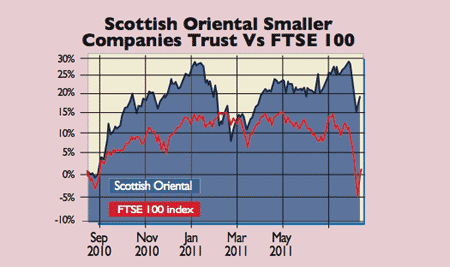
When markets are plunging, as we saw earlier this month, it’s an unnerving experience. But it can also be exciting, because when markets fall it can represent a good time to buy. So if you felt like nibbling at a stockmarket you’ve had on your watch list for a while, what’s the best way to do it? One option we like is to use investment trusts.
Investment trusts are stockmarket listed companies that buy shares in other companies. As such they compete with other funds, such as unit trusts, to take your money and invest it for you. At first glance, many of the claimed benefits are the same – you get instant diversification, the (sometimes illusory) expertise of the fund manager, and a simple structure whereby a single investment gets you access to entire markets or sectors.
However, we much prefer investment trusts for several reasons. For a start, they are not as high profile as unit trusts. There are only around 400 of them, as opposed to 2,500-odd unit trusts and open-ended investment companies (OEICs). When an investment is poorly understood, that often makes for a fertile hunting ground for bargains.
- Video tutorial: Why we prefer investment trusts
Next, they are unable to market themselves individually, and do not offer the generous commissions to financial advisers often available from unit trusts. So they tend to be cheaper. The Association of Investment Companies (AIC) recently found that two thirds of 242 trusts they surveyed had a total expense ratio (TER) of less than 1.5% (compared to 1.67% for OEICs and unit trusts). In some sectors this was far lower – two thirds of firms in the UK Growth and Income sector boast a TER of under 1%. Better still, the bigger an investment trust gets, the lower the TER (usually).
There are a couple of other features to consider. As listed companies, the share price of investment trusts is set by supply and demand. So the market capitalisation of a trust can be below the value of the investments it holds (it trades at a “discount to net asset value” (NAV)). A discount of 10% means you can buy £1-worth of assets for 90p. A more controversial characteristic is gearing. Investment trusts can borrow to invest. This makes them more volatile than unit trusts but boosts returns in good years.
So what’s the performance like? Over the past decade, investment trusts beat unit trusts in eight out of nine sectors surveyed by broker Collins Stewart. Over the past year, even the one that has struggled over that period – smaller company trusts – has turned in a rise of nearly 40%. What more evidence do you need?
Which trusts to invest in
Let’s start with one investment trust we’d still avoid – the much-hyped Fidelity China Special Situations Fund, managed by Anthony Bolton. After rising to a high of 130p late last year, the shares have slumped to below their launch price of 100p. With annual fees a toppy 1.5% a year (plus a performance fee) and China fighting inflation and cutting back on government stimulus, this is no place to find a bargain. MoneyWeek Asia’s Cris Sholto Heaton prefers the Scottish Oriental Smaller Companies Trust (LSE: SST). It boasts a much broader emerging market country remit, a far lower TER of 1.03%, and trades on a discount to NAV of 8%. It is up 140% over three years.
Drip feed or lump sum?
When it comes to buying an investment trust (or any other investment for that matter), there are two schools of thought as to how to do it. The first option is to drip feed a regular amount in every month, to reap the supposed benefits of “pound-cost averaging”. So, for example, let’s say you have £600 to invest over three months. The price of the share you decide to buy is £2 at the start of month A, £1 at the start of month B and £3.20 at the start of month C. By the end of month C it is £3.50. So spending £200 at the start of each month buys you 100 shares (£200/£2), then 200 shares, and then another 62 shares. So you’ve bought 362 shares, worth £3.50 each at the end of month C – that’s a total of £1,267. What if you’d just put £600 in when the share price was £2? You’d have ended up with 300 shares, which would be worth £1,050 (300 x £3.50) at the end of month C. So by pound-cost averaging you have smoothed out volatility by buying some shares when they are cheap in month B.
But does it always work? No. Sure, in a bear market you will benefit from not being fully invested at the start. The AIC looked at two such periods from March 2000 to October 2002 and October 2007 to February 2009. They found that the respective losses were 30% and 33% for pound-cost averaging compared to 37% and 44% for lump sum investing.
But stretch that out to the ten-year period to the end of June and they found that £50 a month invested in a typical investment trust would have turned into £10,057, versus £11,855 for a £6,000 lump sum at the start. This suggests that for the long-term investor time in the market – and you get more of it with an up-front lump sum – matters (in part because you’ll enjoy more dividend income). No-one says picking an entry point is easy. But it seems the extra effort is often rewarded.
• This article was originally published in MoneyWeek magazine issue number 551 on 19 August 2011, and was available exclusively to magazine subscribers. To read all our subscriber-only articles right away, subscribe to MoneyWeek magazine.